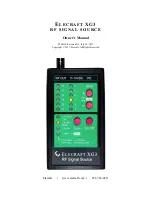
Appendix I
LE3000S
21
20.00 2.02k 4.02k 6.02k 8.01k 10.0k 12.0k 14.0k 16.0k 18.0k 20.0k 22.0k 24.0k
FREQ(Hz)
-180.0
-175.0
-170.0
-165.0
-160.0
-155.0
-150.0
-145.0
-140.0
-135.0
-130.0
-125.0
-120.0
-115.0
-110.0
-105.0
-100.0
AMP1(dBFS)
AUDIO PRECISION FFT
vs
14 NOV 93 12:54:19
20.00 2.02k 4.02k 6.02k 8.01k 10.0k 12.0k 14.0k 16.0k 18.0k 20.0k 22.0k 24.0k
FREQ(Hz)
-180.0
-175.0
-170.0
-165.0
-160.0
-155.0
-150.0
-145.0
-140.0
-135.0
-130.0
-125.0
-120.0
-115.0
-110.0
-105.0
-100.0
AMP1(dBFS)
AUDIO PRECISION FFT
vs
14 NOV 93 12:47:26
20.00 2.02k 4.02k 6.02k 8.01k 10.0k 12.0k 14.0k 16.0k 18.0k 20.0k 22.0k 24.0k
FREQ(Hz)
-180.0
-175.0
-170.0
-165.0
-160.0
-155.0
-150.0
-145.0
-140.0
-135.0
-130.0
-125.0
-120.0
-115.0
-110.0
-105.0
-100.0
AMP1(dBFS)
AUDIO PRECISION FFT
vs
14 NOV 93 12:45:07
Fig. 4 - Acoustic Bit Correction Fig. 5 - ABC HP-NS2 Fig. 6 - dither onl
y
16 (top), 18, 20, and 22 bits 16 (top), 18, 20, and 22 bits 16 (top), 18, 20, and 22 bits
no input signal -120 dB 1 kHz sine tone -120 dB 1 kHz sine tone
Acoustic Bit Correction may be used with words of lengths wider than 16 bits. Figure 4 shows
the noise floor of Acoustic Bit Correction (High Pass, NS2) without a signal at 16, 18, 20, and
22 bit wordlengths. Note the curved noise-floor with lowest level in the ear’s most sensitive
mid-range region.
Figure 5 shows Acoustic Bit Correction (High Pass, NS2) applied to a 24 bit input, reducing to
16, 18, 20, and 22 bit output widths. Notice that there is no noise modulation present.
Figure 6 shows the effect of high-pass triangular dither only. The more coherent data in the
dithered bits, the better the dithering process works. Note that dithering from 24 bits to 22 bits
has a lower noise floor but more visible distortion components than dithering to a shorter word
length, due to fewer bits in the portion of the word being truncated.
20.00 2.02k 4.02k 6.02k 8.01k 10.0k 12.0k 14.0k 16.0k 18.0k 20.0k 22.0k 24.0k
FREQ(Hz)
-170.0
-165.0
-160.0
-155.0
-150.0
-145.0
-140.0
-135.0
-130.0
-125.0
-120.0
-115.0
-110.0
-105.0
-100.0
-95.00
-90.00
-85.00
-80.00
AMP1(dBFS)
AUDIO PRECISION FFT
vs
14 NOV 93 15:50:12
20.00 2.02k 4.02k 6.02k 8.01k 10.0k 12.0k 14.0k 16.0k 18.0k 20.0k 22.0k 24.0k
FREQ(Hz)
-170.0
-165.0
-160.0
-155.0
-150.0
-145.0
-140.0
-135.0
-130.0
-125.0
-120.0
-115.0
-110.0
-105.0
-100.0
-95.00
-90.00
-85.00
-80.00
AMP1(dBFS)
AUDIO PRECISION FFT
vs
14 NOV 93 13:58:03
Fig. 7- 16 bit input signal -100 dB Fig. 8- 16 bit input signal -100 dB
truncation by previous processing additional processing and truncation
Should dither be applied to input signals of 16 bit word length? Figure 7 shows a -100 dB tone
of 16 bit word width with no dither or noise shaping. Note the presence of all of the odd
harmonics, created when the truncation process turned the tone into a 1 lsb square wave.
Figure 8 shows the result of applying additional processing to this signal, and truncating the
result, thereby creating additional distortion components.
Содержание 3000S
Страница 2: ......









































